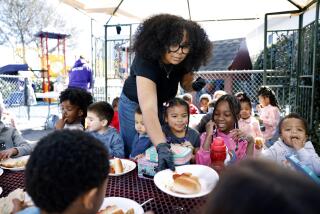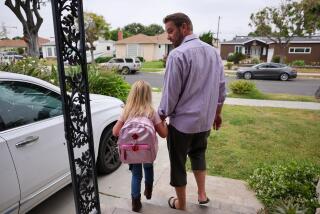Kindergartners struggle to learn online. But this mother-daughter duo keeps them glued
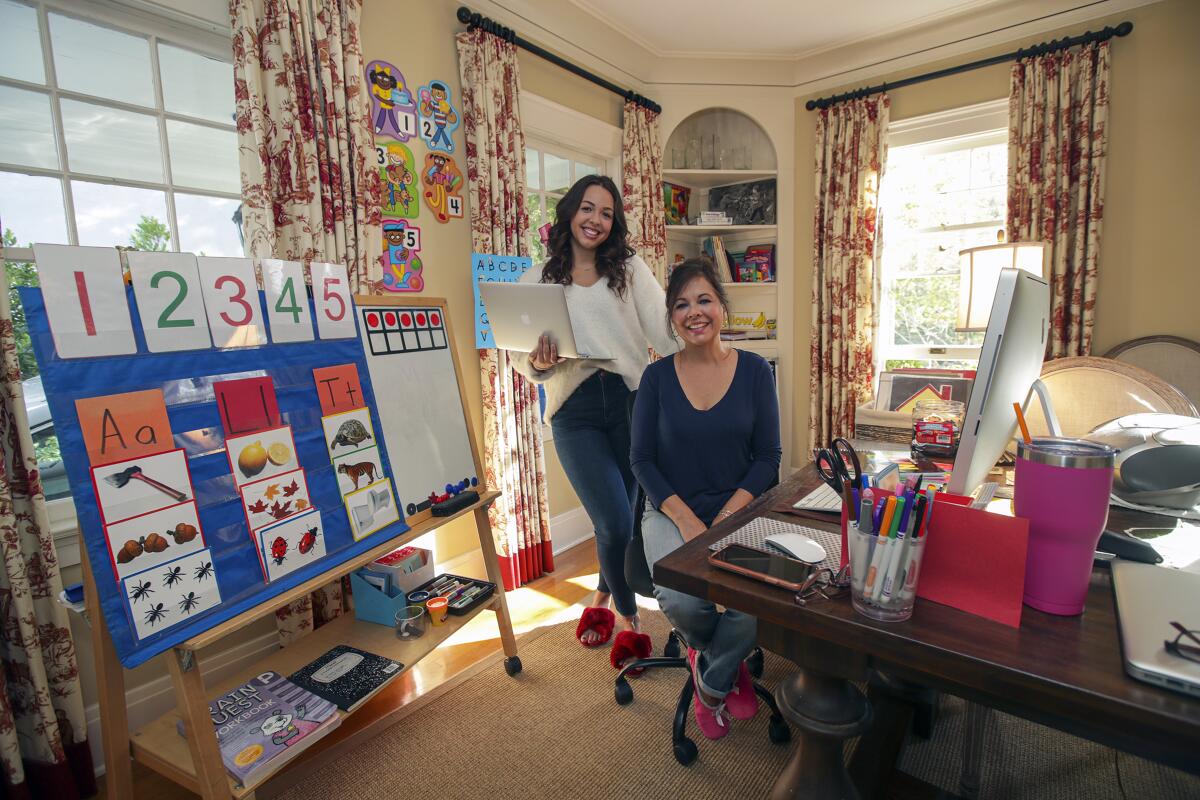
It was five minutes past 9 a.m. on the 59th day of school, and Ms. Tai was running late.
“Dad! The internet’s not connecting!” the Los Angeles Unified School District kindergarten teacher hollered from her pocket-size classroom — little more than a desk and a couple of posters, screened off from a dresser and a tidy twin bed.
“Mom’s is working!” her father, Bob Carter, called back, his voice nearly drowned out by his wife’s cheerful morning song.
A year ago, mother and daughter taught in classrooms one room apart at Bushnell Way Elementary School in Highland Park — Mrs. Carter with 4-year-olds, Ms. Tai in a mixed group of children ages 4 and 5. Many of the felt puppets and linking cubes they shared there are the same ones Karen Carter used when her daughter was a student in her classroom. Out of respect for her mother’s long tenure, Tai Carter goes by Ms. Tai at school.
Now, the pair teach their pint-size students from home, keeping L.A.’s youngest learners engaged online even as kindergarten enrollment has plummeted and online attendance has slumped.
“I try, but it doesn’t always go as planned,” Ms. Tai explained as she waited for her laptop to restart. “By time I get in there, half of them will be gone.”
Remote learning has strained educators across the country, from Head Start to the Ivy League. But for public school kindergarten teachers like the Carters, this fall has been especially hard. Just 19 states require kindergarten, and in those like California that don’t, enrollment has dropped off a cliff.
The Los Angeles Unified School District alone lost 6,000 kindergartners this year — more than one-third of the total drop in enrollment districtwide — and reports suggest that many who remain log into class only sporadically. For those who show up, technical issues abound.
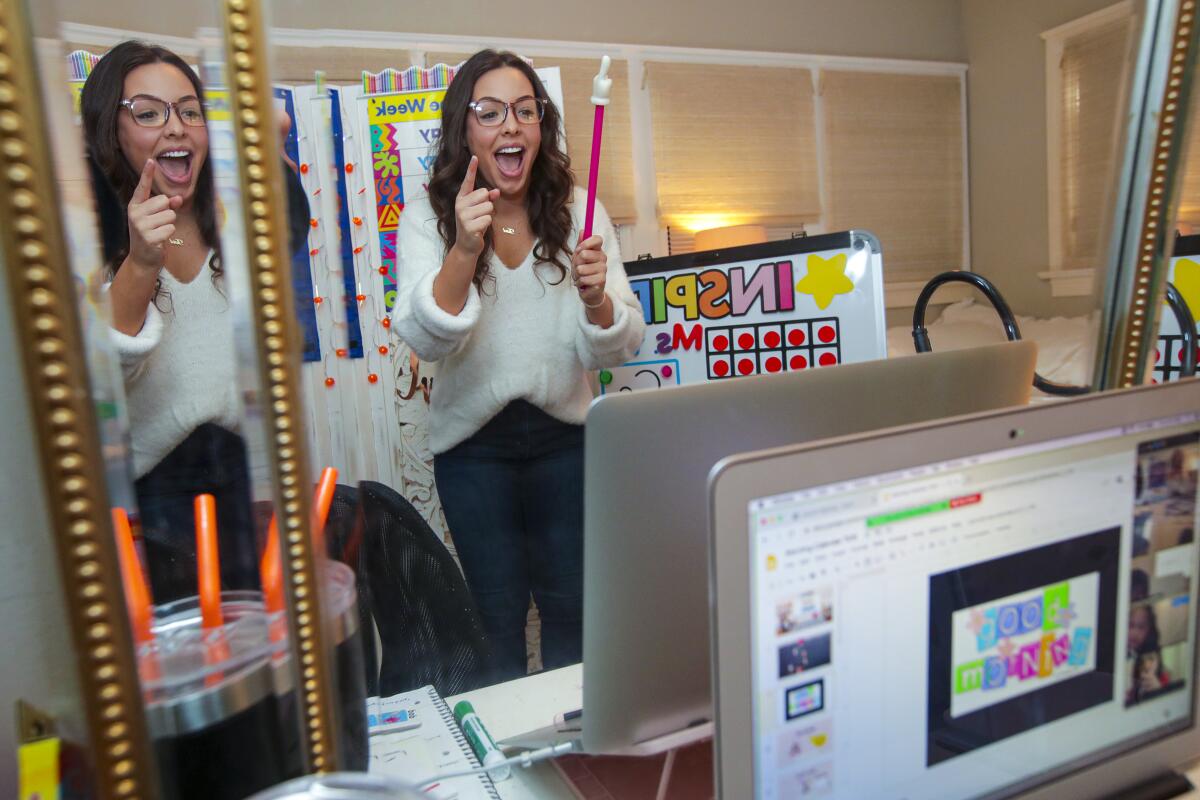
“We were stuck in the waiting room!” one little boy cried when Ms. Tai’s classroom finally opened at 9:08 a.m. “It kept loading for years and years!”
Traditionally, kindergarten has been the doorway between early childhood and elementary education: a passage from finger paints to phonics, sandboxes to subtraction. But for children who started their academic career online this fall, that doorway has instead become a kind of waiting room. Academically, kindergarten is the same online as it was “in-seat” before COVID-19. But experts say academics are only a small part of what young students are meant to learn in school.
“Teaching a kindergarten student is just drastically different than teaching a third-grader,” said Aaron Loewenberg, an early and elementary education policy analyst at the New America think tank. “For some, it’s their first time being in school — that’s where they learn how to line up, how to raise their hand to ask a question, how not to push their classmates, how to go to the playground. The basics of how to go to school is done in the kindergarten year.”
Of course, kindergarten is now very much also about reading and math — a first-grader can’t keep up unless she’s already mastered simple arithmetic and sight words. But those skills depend on the ability to hold a pencil and sit still in a chair, abilities that are not innate or intuitive to a child who may still wear Pull-Ups at night. They require physical conditioning and careful refinement, which educators say are virtually impossible to replicate through a Chromebook.
“I’ve been an early educator for 35 years and it’s really hard for young children to learn on Zoom,” said Mrs. Carter, who re-created her kindergarten classroom around her dining table. “Especially with everything they’re dealing with at home. Dad’s lost a job or Grandma’s sick — I have a lot of crying babies in the background. Sometimes the child will Zoom from inside a car, because it’s the only quiet place they can find.”
Ms. Tai agreed.
“They want to talk, they want to share, but there’s never enough time,” she said. “They’re making so much less progress, but we’re testing them in the exact same way as we would in the classroom.”
Yet despite these struggles, Ms. Tai and Mrs. Carter have a strength most kindergarten teachers don’t: each other. Mrs. Carter has been at Bushnell Way longer than any other teacher — so long she now regularly instructs the children of her former students — while Ms. Tai is “by far the youngest” on staff. Together, they’ve got all the expertise of a 57-year-old veteran educator combined with the technological savvy of a 27-year-old digital native.
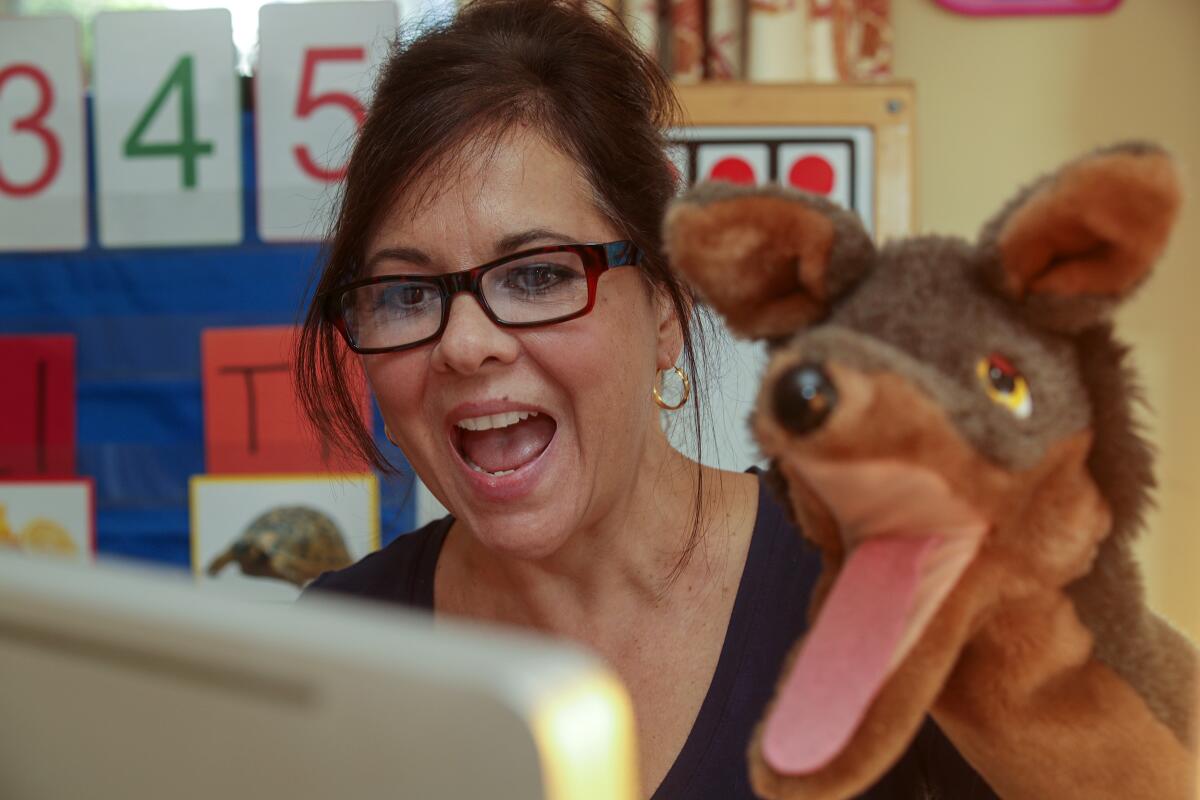
“What I struggle with, she can do in 10 minutes,” Mrs. Carter said. “Then I help her with curriculum, just because I have so much experience. She’ll run downstairs and get one of my games, and I’ll text her when I need help.”
It’s a small piece of normalcy in an upside-down school year. When they were teaching down the hall from each other, Ms. Tai would frequently pop into her mother’s classroom for advice or a picture book. In that regard, working from home is much the same.
“Having her with me in the same place, I can bounce ideas off of her,” she said. “I feel for all the new teachers who are alone.”
Of course, there are strains as well. Ms. Tai moved back to her parents’ home in Pasadena after she got her teaching credential from Cal State L.A., but she’d planned to find her own place by the end of the 2019-20 school year. Instead, she found herself co-working with her sister, a teacher’s aid at Bushnell Way, from their respective bedrooms, while their mother teaches in the dining room and their father, an HR consultant, holds virtual meetings downstairs.
With so much happening in one home, it can sometimes be difficult to keep the noise of one classroom from bleeding into another. And just as other daughters like to borrow their mothers’ good jewelry, Ms. Tai is constantly carrying off Mrs. Carter’s classroom materials.
“You have so much more stuff than me!” the younger teacher said.
“Well, we share,” her mother said. “That’s 35 years, compared to six months.”
Because they work so closely together, the two teachers look much alike in their virtual classrooms. Both cap lessons at under 10 minutes, stopping to jump, dance and sing between math blocks and story time.
“That’s a T, right?” Mrs. Carter’s plush friend Sparky asked the screen. It was 9:15, and the teacher had promised to put a sticker on her face for every letter the puppet could correctly name. So far, he was striking out.
“You’re not a very good learner, actually,” one 4-year-old student accused. But he was soon roaring with laughter as Mrs. Carter began to adorn herself.
“Is that a T on my ear?” she asked, pointing. “Oh, you think that’s hilarious, huh?”
While Mrs. Carter relies on the same felt boards and hand puppets she used in her physical classroom, Ms. Tai has turned to more technical tools. Her kindergartners work with digital manipulatives rather than the physical ones her mother’s students use. She draws on an iPad whiteboard and projects worksheets using a smartphone — hacks she learned from other teachers on social media.
“I get a lot of creative ideas from teacher TikTok,” she said. “I feel like I’ve been teaching online longer than I have in the actual classroom.”
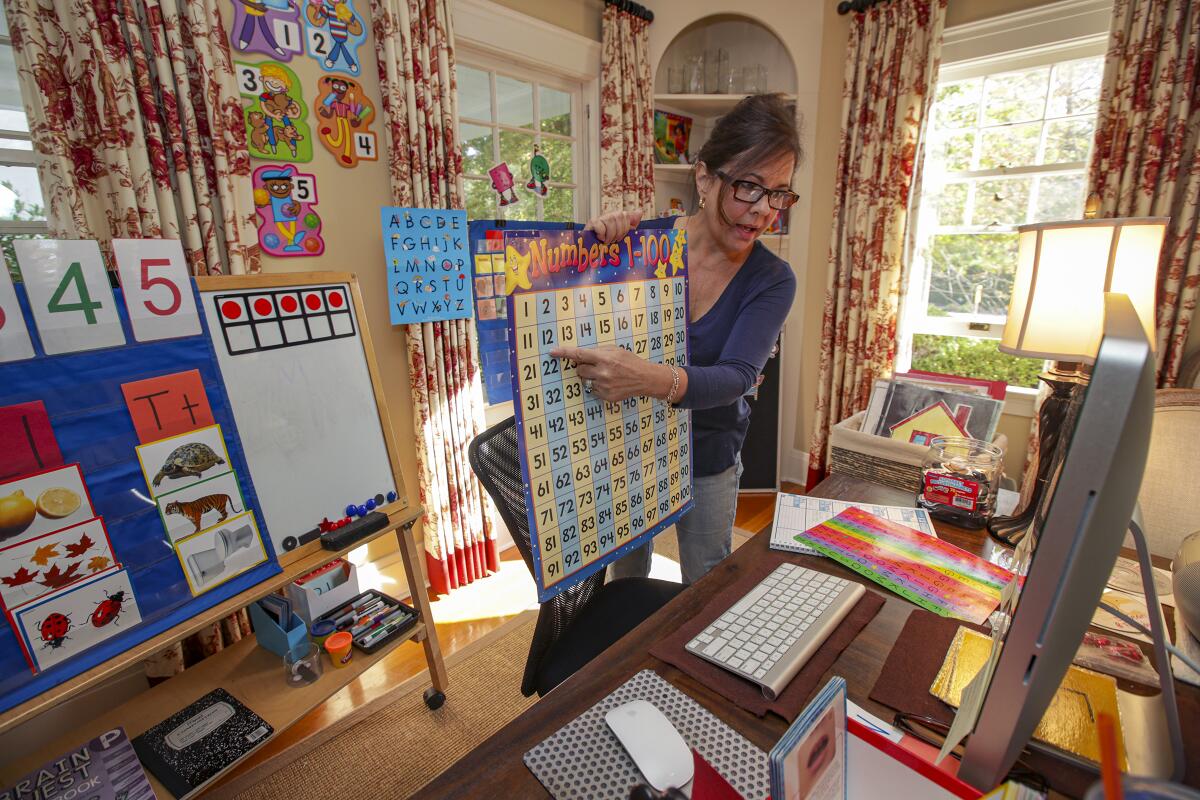
But neither re-creating a physical classroom nor reinventing it for a two-dimensional world can solve the more fundamental problem facing teachers of very young students, experts warn.
“The biggest thing we want [4- and 5-year-olds] to learn when they go to kindergarten and [transitional kindergarten] is relationships,” said Adria Taha-Resnick, a professor of early childhood studies at Cal State Channel Islands. “The hard part is getting them invested from day one in wanting to be there.”
Here, older children have a huge advantage over younger ones, because they know their schools and their classmates already, even if the format is different and they’d never met their teachers before. For kindergartners, online learning sits squarely at odds with their very new ability to distinguish reality from make-believe. To Mrs. Carter’s students especially, school is a lot like Sesame Street — friendly and familiar, but definitely not of this world.
“To them, I’m just a character on the screen,” Mrs. Carter explained. “I’m not real to them.”
By contrast, most of Ms. Tai’s students had at least a few months of class in person before schools shut down in March. In general, they’ve received her more warmly. Yet the young teacher said she still struggled to form the kind of connections she cherished in the classroom.
“Some of them have never met me in real life,” she said. “I want to be with them, I want them to know how much I care about them, and that stuff’s hard to show over a computer screen.”
Instead, Ms. Tai finds herself worrying about everything she can’t give her young students from home.
“Kindergarten sets the foundation for the rest of their schooling — they really do need those skills in first grade, or they’re going to completely fall behind,” the teacher said. “It’s stressing me out. I think about it all the time.”
Yet for the brief time she has with her student each day, Ms. Tai keeps those worries hidden. The moment the camera flickered on, her posture straightened and her cheerful voice rang out brightly. Children shouted over one another to be heard as she guided them through their morning song and daily affirmations, like a star trying to keep tiny planets in orbit. No matter: Inside 10 minutes, her students were fading.
And so, on the 59th day of the most difficult school year in living memory, Bushnell Way’s youngest kindergarten teacher jumped up and started dancing.
More to Read
Sign up for Essential California
The most important California stories and recommendations in your inbox every morning.
You may occasionally receive promotional content from the Los Angeles Times.


